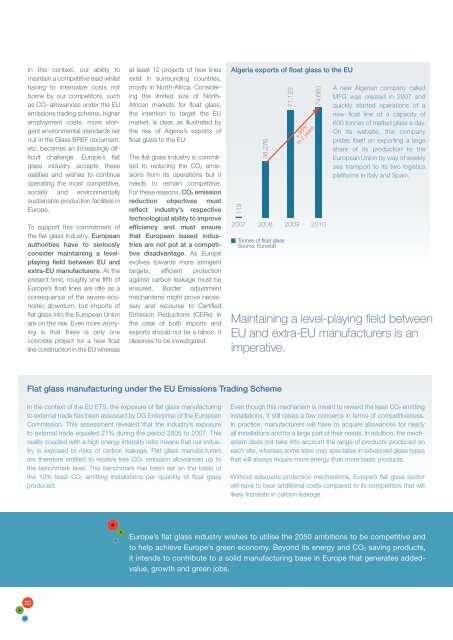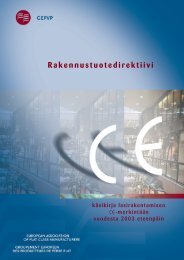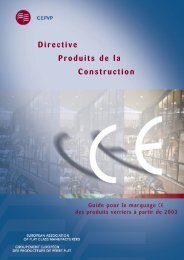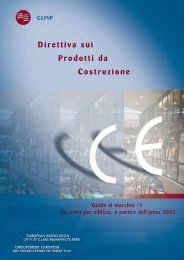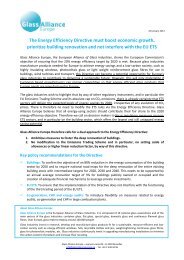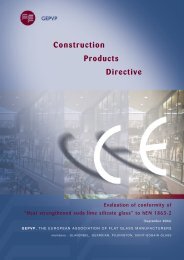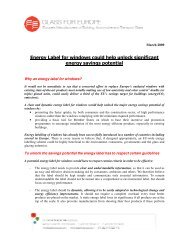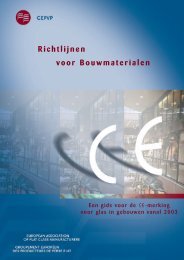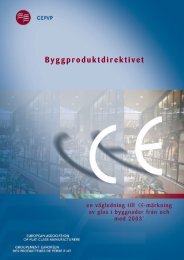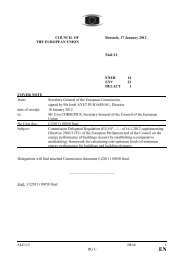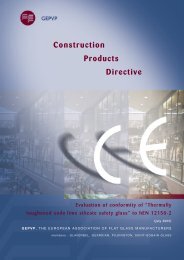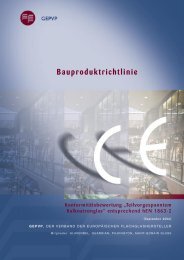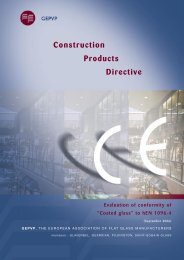Europe's flat glass industry in a competitive low ... - Glass for Europe
Europe's flat glass industry in a competitive low ... - Glass for Europe
Europe's flat glass industry in a competitive low ... - Glass for Europe
Create successful ePaper yourself
Turn your PDF publications into a flip-book with our unique Google optimized e-Paper software.
In this context, our ability to<br />
ma<strong>in</strong>ta<strong>in</strong> a <strong>competitive</strong> lead whilst<br />
hav<strong>in</strong>g to <strong>in</strong>ternalize costs not<br />
borne by our competitors, such<br />
as CO2 al<strong>low</strong>ances under the EU<br />
emissions trad<strong>in</strong>g scheme, higher<br />
employment costs, more str<strong>in</strong>gent<br />
environmental standards set<br />
out <strong>in</strong> the <strong>Glass</strong> BREF document,<br />
etc. becomes an <strong>in</strong>creas<strong>in</strong>gly difficult<br />
challenge. <strong>Europe</strong>’s <strong>flat</strong><br />
<strong>glass</strong> <strong><strong>in</strong>dustry</strong> accepts these<br />
realities and wishes to cont<strong>in</strong>ue<br />
operat<strong>in</strong>g the most <strong>competitive</strong>,<br />
socially and environmentally<br />
susta<strong>in</strong>able production facilities <strong>in</strong><br />
<strong>Europe</strong>.<br />
To support this commitment of<br />
the <strong>flat</strong> <strong>glass</strong> <strong><strong>in</strong>dustry</strong>, <strong>Europe</strong>an<br />
authorities have to seriously<br />
consider ma<strong>in</strong>ta<strong>in</strong><strong>in</strong>g a levelplay<strong>in</strong>g<br />
field between EU and<br />
extra-EU manufacturers. At the<br />
present time, roughly one fifth of<br />
<strong>Europe</strong>’s float l<strong>in</strong>es are idle as a<br />
consequence of the severe economic<br />
downturn, but imports of<br />
<strong>flat</strong> <strong>glass</strong> <strong>in</strong>to the <strong>Europe</strong>an Union<br />
are on the rise. Even more worry<strong>in</strong>g<br />
is that there is only one<br />
concrete project <strong>for</strong> a new float<br />
l<strong>in</strong>e construction <strong>in</strong> the EU whereas<br />
at least 12 projects of new l<strong>in</strong>es<br />
exist <strong>in</strong> surround<strong>in</strong>g countries,<br />
mostly <strong>in</strong> North-Africa. Consider<strong>in</strong>g<br />
the limited size of North-<br />
African markets <strong>for</strong> float <strong>glass</strong>,<br />
the <strong>in</strong>tention to target the EU<br />
market, is clear, as illustrated by<br />
the rise of Algeria’s exports of<br />
float <strong>glass</strong> to the EU.<br />
The <strong>flat</strong> <strong>glass</strong> <strong><strong>in</strong>dustry</strong> is committed<br />
to reduc<strong>in</strong>g the CO2 emissions<br />
from its operations but it<br />
needs to rema<strong>in</strong> <strong>competitive</strong>.<br />
For these reasons, CO2 emission<br />
reduction objectives must<br />
reflect <strong><strong>in</strong>dustry</strong>’s respective<br />
technological ability to improve<br />
efficiency and must ensure<br />
that <strong>Europe</strong>an based <strong>in</strong>dustries<br />
are not put at a <strong>competitive</strong><br />
disadvantage. As <strong>Europe</strong><br />
evolves towards more str<strong>in</strong>gent<br />
targets, efficient protection<br />
aga<strong>in</strong>st carbon leakage must be<br />
ensured. Border adjustment<br />
mechanisms might prove necessary<br />
and recourse to Certified<br />
Emission Reductions (CERs) <strong>in</strong><br />
the case of both imports and<br />
exports should not be a taboo. It<br />
deserves to be <strong>in</strong>vestigated.<br />
Algeria exports of float <strong>glass</strong> to the EU<br />
119<br />
2007<br />
38,276<br />
2008<br />
Tonnes of float <strong>glass</strong><br />
Source: Eurostat<br />
71,122<br />
2009<br />
+ 95%<br />
<strong>in</strong> 2 years<br />
74,660<br />
2010<br />
A new Algerian company called<br />
MFG was created <strong>in</strong> 2007 and<br />
quickly started operations of a<br />
new float l<strong>in</strong>e of a capacity of<br />
600 tonnes of melted <strong>glass</strong> a day.<br />
On its website, this company<br />
prides itself on export<strong>in</strong>g a large<br />
share of its production to the<br />
<strong>Europe</strong>an Union by way of weekly<br />
sea transport to its two logistics<br />
plat<strong>for</strong>ms <strong>in</strong> Italy and Spa<strong>in</strong>.<br />
Ma<strong>in</strong>ta<strong>in</strong><strong>in</strong>g a level-play<strong>in</strong>g field between<br />
EU and extra-EU manufacturers is an<br />
imperative.<br />
Flat <strong>glass</strong> manufactur<strong>in</strong>g under the EU Emissions Trad<strong>in</strong>g Scheme<br />
In the context of the EU ETS, the exposure of <strong>flat</strong> <strong>glass</strong> manufactur<strong>in</strong>g<br />
to external trade has been assessed by DG Enterprise of the <strong>Europe</strong>an<br />
Commission. This assessment revealed that the <strong><strong>in</strong>dustry</strong>’s exposure<br />
to external trade equalled 21% dur<strong>in</strong>g the period 2005 to 2007. This<br />
reality coupled with a high energy <strong>in</strong>tensity ratio means that our <strong><strong>in</strong>dustry</strong><br />
is exposed to risks of carbon leakage. Flat <strong>glass</strong> manufacturers<br />
are there<strong>for</strong>e entitled to receive free CO2 emission al<strong>low</strong>ances up to<br />
the benchmark level. This benchmark has been set on the basis of<br />
the 10% least CO2 emitt<strong>in</strong>g <strong>in</strong>stallations per quantity of float <strong>glass</strong><br />
produced.<br />
Even though this mechanism is meant to reward the least CO2 emitt<strong>in</strong>g<br />
<strong>in</strong>stallations, it still raises a few concerns <strong>in</strong> terms of <strong>competitive</strong>ness.<br />
In practice, manufacturers will have to acquire al<strong>low</strong>ances <strong>for</strong> nearly<br />
all <strong>in</strong>stallations and <strong>for</strong> a large part of their needs. In addition, the mechanism<br />
does not take <strong>in</strong>to account the range of products produced on<br />
each site, whereas some sites may specialise <strong>in</strong> advanced <strong>glass</strong> types<br />
that will always require more energy than more basic products.<br />
Without adequate protection mechanisms, <strong>Europe</strong>’s <strong>flat</strong> <strong>glass</strong> sector<br />
will have to bear additional costs compared to its competitors that will<br />
likely translate <strong>in</strong> carbon leakage.<br />
<strong>Europe</strong>’s <strong>flat</strong> <strong>glass</strong> <strong><strong>in</strong>dustry</strong> wishes to utilise the 2050 ambitions to be <strong>competitive</strong> and<br />
to help achieve <strong>Europe</strong>’s green economy. Beyond its energy and CO 2 sav<strong>in</strong>g products,<br />
it <strong>in</strong>tends to contribute to a solid manufactur<strong>in</strong>g base <strong>in</strong> <strong>Europe</strong> that generates addedvalue,<br />
growth and green jobs.<br />
30


